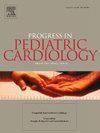使用Trufill®n-丁基氰基丙烯酸酯(n-BCA)液体栓塞系统经导管栓塞主动脉肺侧支;单中心体验
IF 0.8
Q4 PEDIATRICS
引用次数: 0
摘要
背景肺脏络(APCs)常见于紫绀型心脏病患者。这些apc与接受Glenn或Fontan手术的患者的正常肺血流竞争。apc也见于囊性纤维化(CF)患者,已知其可引起咯血。经导管闭塞的APCs以前已描述使用线圈,血管塞,和聚乙烯醇(PVA)颗粒。我们介绍了一系列使用Trufill n-BCA液体栓塞APCs的患者。目的:本研究旨在评估Trufill®n-丁基氰基丙烯酸酯(n-BCA)用于先天性心脏病和囊性纤维化患者经导管肺动脉侧支血管栓塞的安全性和有效性,特别是在传统栓塞方法有限的病例或严重咯血患者中。方法2009 - 2012年共行18例导管术(15例),其中APCs采用n-BCA栓塞。平均年龄8.5岁(范围4个月至21岁),平均体重29公斤(范围7-72公斤)。3例患者有囊性纤维化(CF)并咯血。其余的患者患有青紫型先天性心脏病,并接受了双向Glenn或Fontan手术。其中一名先天性心脏病患者因咯血进行了两次导管插入术(间隔2.5年)。结果所有apc患者的bca栓塞术在技术上均成功。3例出现咯血的囊性纤维化患者症状改善,不需要重复置管。1例紫绀型先天性心脏病伴咯血急性好转;然而,2.5年后,她再次咯血,需要额外的APCs栓塞。该患者也出现了n-BCA使用的并发症。在左胸外侧动脉APC闭塞后,她出现了覆盖皮肤的红斑,几天后形成了一个小溃疡(可能是由于软组织/皮肤缺血)。溃疡不需任何特殊治疗就消失了。唯一的其他并发症发生在APC栓塞期间,n-BCA无意中栓塞到尺动脉,导致先前闭塞的桡动脉部分闭塞。血管手术成功地切除了这些物质,病人没有受到持久的影响。没有其他主要的n- bca相关并发症,如脑血管意外、肺栓塞或导管粘连。结论n- bca是fda批准的用于脑动静脉畸形栓塞的液体栓剂。PVA颗粒,以前用于脑avm,具有高再通率,因此已被Trufill n-BCA或Onyx液体栓塞系统所取代。使用线圈、血管塞和PVA颗粒栓塞APCs,所有这些方法都与不同的再通率相关。我们认为n-BCA提供了一种更永久的APC闭塞形式,并降低了再通的发生率。然而,应该谨慎,特别是当栓塞动脉或apc时,可能有分支延伸到皮下组织,因为与其他闭塞方法相比,n-BCA可能不太宽容。本文章由计算机程序翻译,如有差异,请以英文原文为准。
Transcatheter embolization of aortopulmonary collaterals using the Trufill® n-Butylcyanoacrylate (n-BCA) liquid embolic system; A single-center experience
Background
Aortopulmonary collaterals (APCs) are commonly found in patients with cyanotic heart disease. These APCs compete with normal pulmonary blood flow in patients who have undergone Glenn or Fontan surgery. APCs are also seen in patients with cystic fibrosis (CF), where they are known to cause hemoptysis. Transcatheter occlusion of APCs has previously been described using coils, vascular plugs, and polyvinyl alcohol (PVA) particles. We present a series of patients in which the APCs were embolized using Trufill n-BCA liquid.
Objectives
This study aims to evaluate the safety and effectiveness of Trufill® N-Butylcyanoacrylate (n-BCA) for transcatheter embolization of aortopulmonary collateral vessels in patients with congenital heart disease and cystic fibrosis, particularly in cases where traditional embolization methods are limited or in patients with significant hemoptysis.
Methods
From 2009 to 2012, a total of 18 catheterization procedures were performed (in 15 patients), in which APCs were embolized using n-BCA. The mean age was 8.5 years (range: 4 months to 21 years), with a mean weight of 29 kg (range: 7–72 kg). Three patients had cystic fibrosis (CF) and presented with hemoptysis. The remaining patients had cyanotic congenital heart disease and had undergone Bidirectional Glenn or Fontan procedures. One of the congenital heart disease patients had two catheterization procedures (2.5 years apart) for hemoptysis.
Results
n-BCA embolization of APCs was technically successful in all patients. The three patients with cystic fibrosis who presented with hemoptysis had symptomatic improvement and have not needed repeat catheterization. One patient with cyanotic congenital heart disease and hemoptysis had acute improvement; however, 2.5 years later, she had recurrent hemoptysis and required additional APCs to be embolized. A complication attributable to n-BCA use also occurred in this patient. Following occlusion of an APC arising from the left lateral thoracic artery, she developed erythema of the overlying skin, followed a few days later by the formation of a small ulcer (presumably due to ischemia of the soft tissue/skin). The ulcer resolved without any specific treatment.
The only other complication occurred when n-BCA unintentionally embolized to the ulnar artery during APC embolization, causing partial occlusion in a patient with a previously occluded radial artery. Vascular surgery successfully removed the material, and the patient had no lasting effects. There were no other major n-BCA-related complications such as cerebrovascular accident, pulmonary embolism, or catheter adhesion.
Conclusion
n-BCA is a liquid embolic agent that is FDA-approved for the embolization of cerebral arteriovenous malformations. PVA particles, previously used for cerebral AVMs, have a high recanalization rate and have therefore been replaced by Trufill n-BCA or Onyx liquid embolic systems.
APCs have been embolized using coils, vascular plugs, and PVA particles—all of which are associated with varying rates of recanalization. We believe that n-BCA provides a more permanent form of APC occlusion with a decreased incidence of recanalization.
However, caution should be exercised, especially when embolizing arteries or APCs that may have branches extending to subcutaneous tissue, as n-BCA may be less forgiving compared to other occlusion methods.
求助全文
通过发布文献求助,成功后即可免费获取论文全文。
去求助
来源期刊

PROGRESS IN PEDIATRIC CARDIOLOGY
PEDIATRICS-
CiteScore
0.90
自引率
11.10%
发文量
69
审稿时长
75 days
期刊介绍:
Progress in Pediatric Cardiology is an international journal of review presenting information and experienced opinion of importance in the understanding and management of cardiovascular diseases in children. Each issue is prepared by one or more Guest Editors and reviews a single subject, allowing for comprehensive presentations of complex, multifaceted or rapidly changing topics of clinical and investigative interest.
 求助内容:
求助内容: 应助结果提醒方式:
应助结果提醒方式:


